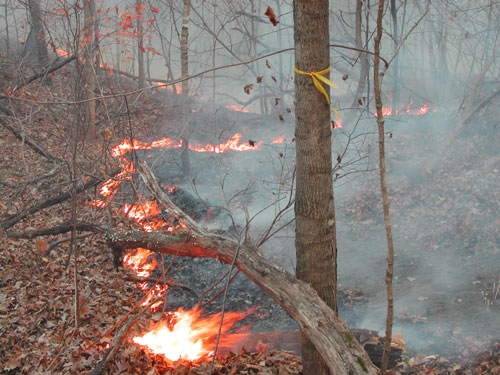You are here
Home ›Prescribed burns planned at Yellow River State Forest for this spring

Yellow River State Forest staff will be conducting prescribed burns between now and May, as weather and other conditions permit. Prescribed burns are used to improve wildlife habitat, control invasive plant species, restore and maintain native plant communities and reduce wildfire potential. Submitted photo.
by Kelli Boylen
freelance writer
Many people believe that fire naturally burned across landscapes over the years due to lightning, but Yellow River State Forester Bruce Blair says it was actually Native Americans who set the fires in an early form of ecological management.
Native Americans understood that the animals they most liked to hunt in the Upper Midwest, such as deer, turkey, bison and elk, all loved to eat acorns and hickory nuts. They understood the oak and hickory trees were quite fire resistant, but maple, bass and ash trees would succumb to the flames. “They were purposely tending the land with fire,” Blair says.
Fires set by lightning striking the ground likely would have been extinguished by the accompanying rain and not spread.
“If you take fire out of the equation, the oaks and hickory trees will eventually disappear,” Blair says. “One hundred percent of the trees that grow in the shade of oaks will be non-oaks. Oaks will only regenerate when there is no shade-tolerant trees growing under them.”
Blair further explains it seems like it would not be a big deal to let the forest go to maple and basswood, but oak and oak-mix woods offer more plant diversity and more wildlife diversity. Oak is also a much more valuable timber, both for lumber and firewood. A state forest is the not the same as a state park, he noted. A forest is managed for multiple uses, including birds and wildlife, public use and timber management.
“Yellow River State Forest strives for sound ecological forest management practices, and that requires us to do burning in the spring and fall,” Blair says.
Prescribed burn units are typically burned every one to five years and vary in size from two to 300 acres or more. Prescribed burns are used to improve wildlife habitat, control invasive plant species, restore and maintain native plant communities and reduce wildfire potential. Ground nesting birds such as pheasants, mallards, bobolinks, dickcissels and many others will benefit from habitat improved with periodic prescribed fire. Most prescribed burns will take place between now and May, and fall fires may also be planned.
For each stand (area) to be burned on Department of Natural Resources (DNR) property in Iowa, Blair and other foresters must create an individualized burn plan. The plan details how many DNR staff are needed, contingency plans if the fire were to go outside the planned boundaries, and planning for smoke can sometimes be tricky.
“The hills and valleys of this area create a lot of variables, we plan as carefully as possible,” says Blair. Their goal is always to keep smoke away from homes and farms.
On any given spring or fall day, Blair is monitoring the weather forecasts for the next day and two days ahead. “We are very weather dependent,” he explains.
Working with the National Weather Service, they chart spot weather forecasts, specifically for Yellow River State Forest. If the weather looks right he starts contacting other foresters and DNR personnel trained in prescribed burns to see if they can assist with staffing needs.
The number of DNR staffers needed can vary greatly, not just based on the size of the area to be burned, but also the terrain of the area to be burned and surrounding landscapes, if any buildings are nearby, if there are natural firebreaks, forescasted dewpoints, etc. Blair considers the minimum number of personnel needed for a burn to be four, but they usually involve more based upon the factors listed.
Usually an active burn lasts for several hours, but deadfall can sometimes smolder for a day or two and is closely monitored. Yellow River State Forest plans to burn 100 to 200 acres annually. The state forest expands over more than 9,000 acres.
The DNR is planning for other burns in northeast Iowa in addition to Yellow River State Forest. Burns will occur throughout four of the counties managed by the DNR Upper Iowa Wildlife Unit. This will include burns in Allamakee, Clayton, Howard and Winneshiek counties. Wildlife Management Areas (WMAs) scheduled to burn include Lansing, Waterloo Creek, Black Hawk Point, Fish Farm Mounds, Clear Creek, Iverson Bottoms and Pool Slough in Allamakee County; Leonard, Sny Magill and Volga River in Clayton County; Hayden Prairie and Turkey River in Howard County; and Chimney Rocks, Falcon Springs, Cardinal Marsh, Coon Creek and South Bear in Winneshiek County.
The local sheriff’s department is always notified when there is a burn taking place, says Blair. If someone observes a fire and they are not sure if it is a controlled burn or not, they are urged to contact the sheriff’s department.
Blair also says anyone with questions about burns is welcome to contact him at 563-586-2090 or Bruce.Blair@dnr.iowa.gov.
“A lot of people love this place,” says Blair about Yellow River State Forest. “Our forest management plans currently include burns. The bottom line is we are not just here for the timber, we are doing our very best for all the plants and animals that live here, and all the people who visit.”

